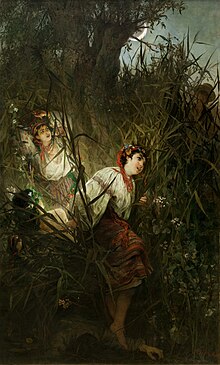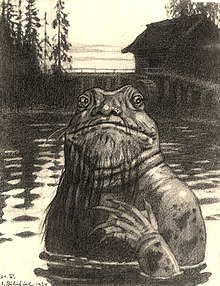
Slavic mythology or Slavic paganism is the religious beliefs, myths, and ritual practices of the Slavs before Christianisation, which occurred at various stages between the 8th and the 13th century.

Kikimora is a legendary creature, a female house spirit in Slavic mythology. Her role in the house is usually juxtaposed with that of the domovoy. The kikimora can either be a "bad" or a "good" spirit, which will depend on the behavior of the homeowner. When the kikimora inhabits a house, she lives behind the stove or in the cellar, and usually produces noises similar to those made by mice in order to obtain food. Kikimory were the first traditional explanation for sleep paralysis in Russian folklore.

Leshy is a tutelary deity of the forests in pagan Slavic mythology. As Leshy rules over the forest and hunting, he may be related to the Slavic god Porewit.

In Slavic mythology, vodyanoy is a water spirit. In Czech and Slovak fairy tales, it is called vodník, and it is considered to be the equivalent creature as the Wassermann or nix of German fairy tales. In Ukrainian fairy tales, it is called “водяник“ (vodyanyk).

In the Slavic religious tradition, Domovoy (Russian: Домовой, literally "[the one] of the household"; also spelled Domovoi, Domovoj, and known as Polish: Domowik, Serbian: Домовик, Ukrainian: Домовик and Belarusian: Дамавік is the household spirit of a given kin. They are deified progenitors, that is to say the fountainhead ancestors of the kin. According to the Russian folklorist E. G. Kagarov, the Domovoy is a personification of the supreme Rod in the microcosm of kinship. Sometimes he has a female counterpart, Domania, the goddess of the household, though he is most often a single god. The Domovoy expresses himself as a number of other spirits of the household in its different functions.
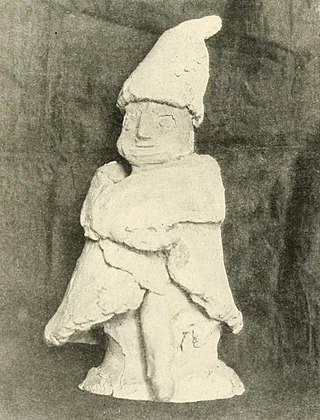
A household deity is a deity or spirit that protects the home, looking after the entire household or certain key members. It has been a common belief in paganism as well as in folklore across many parts of the world.
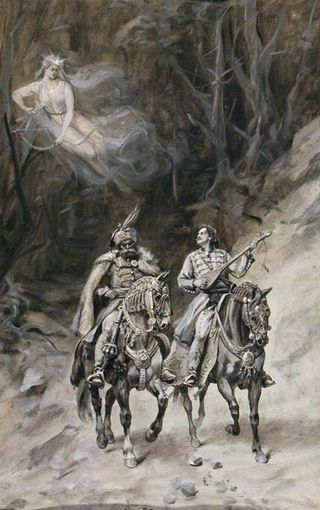
A vila, or víla is a Slavic fairy similar to a nymph.
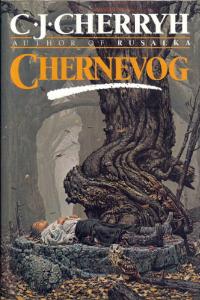
The Russian Stories, also known as the Russian Series, the Russian Trilogy and the Rusalka Trilogy, are a series of fantasy novels by science fiction and fantasy author C. J. Cherryh. The stories are set in medieval Russia along the Dnieper river, in a fictional alternate history of Kievan Rus', a predecessor state of modern-day Russia, Belarus and Ukraine. The three books in the series are Rusalka (1989), Chernevog (1990), and Yvgenie (1991). Rusalka was nominated for a Locus Award in 1990.
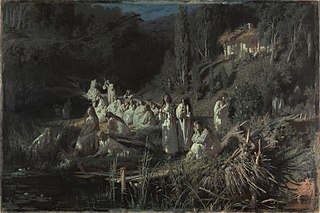
In Slavic folklore, the rusalka is a typically feminine entity, often malicious toward mankind and frequently associated with water, with counterparts in other parts of Europe, such as the French Melusine and the Germanic Nixie. Folklorists have proposed a variety of origins for the entity, including that they may originally stem from Slavic paganism, where they may have been seen as benevolent spirits. Rusalki appear in a variety of media in modern popular culture, particularly in Slavic language-speaking countries, where they frequently resemble the concept of the mermaid.
Mythic humanoids are legendary, folkloric, or mythological creatures that are part human, or that resemble humans through appearance or character. Each culture has different mythical creatures that come from many different origins, and many of these creatures are humanoids. They are often able to talk and in many stories they guide the hero on their journey.

Ukrainian folklore is the folk tradition which has developed in Ukraine and among ethnic Ukrainians. The earliest examples of folklore found in Ukraine is the layer of pan-Slavic folklore that dates back to the ancient Slavic mythology of the Eastern Slavs. Gradually, Ukrainians developed a layer of their own distinct folk culture. Folklore has been an important tool in defining and retaining a cultural distinctiveness in Ukraine in the face of strong assimilatory pressures from neighboring lands.
A water spirit is a kind of supernatural being found in the folklore of many cultures:

Folklore of Russia is folklore of Russians and other ethnic groups of Russia.
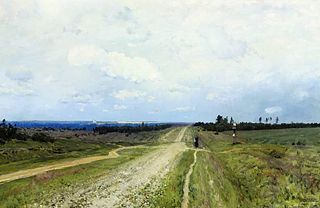
Nav is a phrase used to denote the souls of the dead in Slavic mythology. The singular form is also used as a name for an underworld, over which Veles exercises custody—it is often interpreted as another name for the underground variant of the Vyraj.
In Slavic mythology, bolotnik, balotnik, bolotyanik or błotnik is a male swamp spirit. There are many descriptions of bolotnik. Usually he was portrayed as a man or an old man who has big, frog-like eyes, a green beard and long hair. His body is covered with dirt, algae and fish scales. The legends from the Vitebsk Governorate of Russia said that bolotnik is a dirty, fat, eyeless creature that motionlessly sits at the bottom of the swamp. In some accounts bolotnik is also said to have long arms and a tail. Just like the majority of Slavic water spirits, he would lure and drag people into the water if they get close to the edge. It is believed that bolotnik has neither wife nor children; in the other legends he is married to bolotnitsa, a female swamp spirit.

In Slavic paganism there are a variety of female tutelary spirits associated with water. They have been compared to the Greek Nymphs, and they may be either white (beneficent) or black (maleficent). They may be called Boginki, Navki, Rusalki, and Vily.

The Bear and the Nightingale is a historical fantasy novel written by Katherine Arden. It is Arden's debut novel, and the first novel in the Winternight trilogy. The Bear and the Nightingale is set in medieval Russia and incorporates elements of Russian folklore. The central character is a young girl, Vasya Petrovna, who is able to communicate with mythological creatures, at a time when Orthodox Christianity is attempting to stamp out all belief in such beings.
Moryana is a female sea spirit in Slavic folklore, possibly a goddess. Moryana was a sea vodyanitsa and daughter of the Morskoy Tsar, and also, according to some beliefs, she ruled the winds. Sometimes the moryany/moryanki were said to be numerous spirits of the sea and a marine kind of rusalki, which posed a great threat to ships, but usually Moryana was represented as a single entity.
Lower mythology is a sphere of mythological representations relating to characters who have no divine status, demons and spirits, as opposed to higher gods and the official cult. This opposition is particularly pronounced in world religions.

Unclean force is Slavs collective name of otherworldly forces and creatures: evil spirits, chorts, demons, werewolves and the undead — Domovoy, Polevik, Vodyanoy, Leshy, rusalka, kikimora and other. Common to all of them is belonging to the "unclean", "negative", "out of this world", the otherworldly world and their malevolence towards people.
